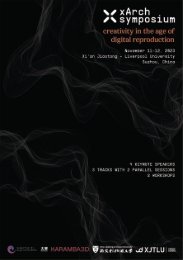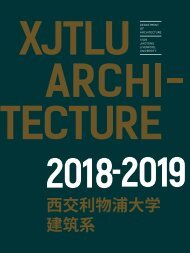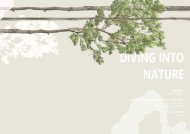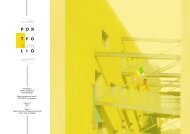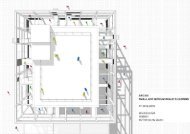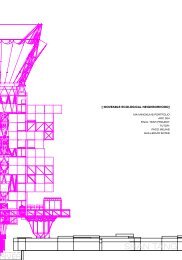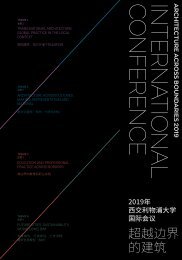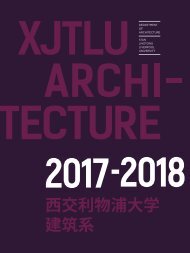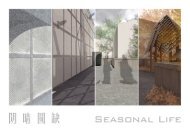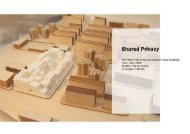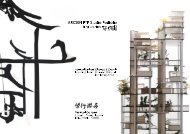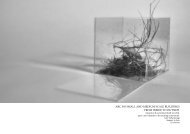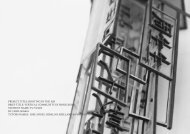XJTLU 2015-16 FYP Folio Bian Zhifan
XJTLU 2015-16 FYP Folio Bian Zhifan / brief E: Places of Transition tutors: Claudia Westermann and Aleksandra Raonic
XJTLU 2015-16 FYP Folio Bian Zhifan / brief E: Places of Transition tutors: Claudia Westermann and Aleksandra Raonic
Create successful ePaper yourself
Turn your PDF publications into a flip-book with our unique Google optimized e-Paper software.
Final Year Project Portfolio<br />
Places of Transition | Shanghai Baoshan | <strong>2015</strong>-20<strong>16</strong><br />
<strong>Bian</strong> <strong>Zhifan</strong><br />
ID Number: 1202002<br />
Tutors: Claudia Westermann & Aleksandra Raonic<br />
Xi'an Jiaotong Liverpool University
Final Year Project Portfolio<br />
Places of Transition | Shanghai Baoshan | <strong>2015</strong>-20<strong>16</strong><br />
<strong>Bian</strong> <strong>Zhifan</strong><br />
ID Number: 1202002<br />
Tutors: Claudia Westermann & Aleksandra Raonic<br />
Xi'an Jiaotong Liverpool University
Content<br />
Site analysis<br />
Yangtze River<br />
Research on navigation<br />
Project description<br />
Concept<br />
Plan<br />
Section<br />
Perspectives<br />
Elevation<br />
Structure and materiality<br />
Concept development<br />
1 - 4<br />
5 - 8<br />
9 - 12<br />
13 - 18<br />
19 - 26<br />
27 - 30<br />
31 - 35<br />
36 - 39<br />
40 - 44<br />
45 - 47<br />
48 - 50<br />
Appendix<br />
Improved works<br />
Oiginal posters<br />
51 - 59<br />
60 - 65<br />
Within the chaos, are we beginning to recognize that there is a kind of<br />
hidden order?<br />
--------------------------------------------------------------------------------Yoshinobu Ashihara
The East Sea<br />
Site<br />
Functions<br />
The Site is located at Baoshan<br />
District, the north of Shanghai.<br />
Baoshan as the entrance of<br />
Shanghai consists of various<br />
functions, such as steel<br />
industry, and has history of anti-<br />
Japanese War. The site, facing<br />
to Yangtze River, is near a park<br />
and residential area.<br />
Gas-turbine Power Plant<br />
Industrial Wharf<br />
Warehouse for icon<br />
Steel Factories<br />
Linjiang Park<br />
Site<br />
International Terminal<br />
Residential area<br />
Paotaiwan Wetland Park<br />
1
Site<br />
activities, views & destinations<br />
Chaotic movements exist in<br />
Shanghai for centuries. Fast transition<br />
happens near the site along with the<br />
movement. The area was transformed<br />
from agricultural land to industry and<br />
back to residential and green space.<br />
The expansion of the Cruise Port<br />
nearby offers opportunities to rethink<br />
Baoshan as a transition point. It is the<br />
entrance and departure to and from<br />
Shanghai, Chongming Island and<br />
the sea. On the site, there is also a<br />
transition from land to water, from solid<br />
to fluid.<br />
Diverse activities happen on the<br />
site. Travellers, tourists and local<br />
residents come to the site with various<br />
purposes, along with different traces<br />
of movement and different staying<br />
time. On the site, the view keeps<br />
changing. The site is half on land and<br />
half on the Yangtze River. Many tourists<br />
coming from the center of Shanghai<br />
or other province on weekends. The<br />
International Terminal at the east of<br />
the site provides the sailing route to<br />
Korea, Japan and southeast Asian as<br />
well.<br />
3
Research<br />
water system & transportation<br />
The site has its special location<br />
at the estuary of Yangtze River.<br />
After the Treaty of Nanjing, 1840,<br />
Shanghai was opened as the<br />
first five treaty ports of China.<br />
Western goods were transported<br />
to Shanghai and the Jiangnan<br />
Region via the long-term<br />
developed water system.<br />
Wuhan<br />
Nanjing<br />
Shanghai<br />
Tibet Plateau<br />
Chongqing<br />
Yichang<br />
Yibing<br />
Based on the water system, western goods could be transported to the inland of China<br />
regardless of the changes of terrain. It was used to be the most efficient transportation<br />
approach. Several big cities, Shanghai, Nanjing, Wuhan, Chongqing, were formed and<br />
grew along the Yangtze River.<br />
5
Yangtze River<br />
Sailing history<br />
The transportation approach<br />
on Yangtze River started two<br />
thousand years ago, from raft<br />
to engine powered ship, from<br />
food transportation, river war<br />
to passenger transportation<br />
and trade.<br />
7
Navigation<br />
History<br />
Raft<br />
Polaris<br />
475<br />
BC<br />
Canoe<br />
Plank-built Boat<br />
221<br />
BC<br />
Sinan<br />
Windsurfing Steering Control Separate Cabin<br />
Castle on Boat<br />
202<br />
BC 220 618 907<br />
960<br />
Wheel Propeller Ship<br />
Sha Ship<br />
Steamship<br />
Bao Ship Engine Powered Ship<br />
Magnetic Needle Marine Compass<br />
Compass<br />
Qianxing Board Nautical Map Sextant<br />
12<br />
79<br />
13<br />
68<br />
<strong>16</strong><br />
44<br />
17<br />
30<br />
18<br />
02<br />
Current Ships<br />
20 <strong>16</strong><br />
1<br />
2<br />
1. The sextant priciple<br />
2. The sextant model<br />
3. Concept drawing<br />
Imitate the sailing<br />
feeling on the<br />
ocean. Circulation is<br />
navigated inside the<br />
Warring State Han Dynasty Tang Dynasty Song Dynasty Ming Dynasty Western exploration (Marco Polo)<br />
11<br />
building.<br />
3<br />
12
Navigation Building Navigation museum & Terminal<br />
Brief investigates possibilities for new concepts for places of transition. Transition usually suggest movement and<br />
are associated with passagers, but also with boundaries and in-between spaces. The brief points to explore the<br />
potential of the in-between space, the third space, and to link the relationship between arrival and departure.<br />
Shanghai as the International metropolis, owning compelling historical scenery of passengers and migrants, fuzzy<br />
routes and chaotic movements. The project aims to respond to the transitional place of Shanghai. How to make it<br />
possible that spaces of the building were able to record all travellers, all their thoughts, hopes and dreams, and all<br />
scenes of people coming and going? How could we address different but coexisting concepts of time -- fast time<br />
and slow time, waiting time, travelling time, flowing time, infinitely?<br />
How to feel time: write<br />
How to escape time: walk<br />
How to release time: breathe<br />
How to travel in time: experience<br />
13 14
Project description<br />
N<br />
Site plan<br />
0 5 10 20 50<br />
Model photos<br />
1. Wall & navigation<br />
2. Site model<br />
3. Circulation<br />
Site model<br />
Starting from navigation, the project aims<br />
to turn the architecture to a navigation<br />
machine. The building explains the history in<br />
the museum and navigate people to imagine<br />
the future. The building works on navigation<br />
from two aspects, exterior and interior. It<br />
navigates objects outside it or distant from it<br />
to determine the location. In addition, from<br />
interior, people’s walking is navigated inside<br />
the building. Two circulations in the navigation<br />
museum and terminal are guided through<br />
specific architectural elements, such as walls<br />
and openings. According to the principle of<br />
sextant, spaces are divided and rearranged<br />
to fit program requirements. The architecture<br />
itself can inspire visitors’ aesthetic experience<br />
based on their daily experience.<br />
As there is an original rhythm on the site, the<br />
building’s construction establishes its own<br />
rhythm while taking replace of old rhythm. It<br />
creates the aesthetic experience and forms<br />
a new built environment instead. However,<br />
the building respects the context to a large<br />
extent. Some walls decline to the ground level<br />
as the landscape or furniture to navigate<br />
people from exterior, which merges with the<br />
natural environment.<br />
15 <strong>16</strong>
Transition<br />
Past - Future<br />
Arrival - Depature<br />
Stay - Go through<br />
Navigation Museum<br />
14<br />
It recalls people of the sailing memory and leads<br />
them to the future. Through the development of<br />
transportation, shipping may be taken replaced<br />
in the future. The museum attempts to imitate the<br />
feeling of travelling on the water.<br />
Manmen Port<br />
Baozhen Port<br />
Terminal<br />
At the entrance of Shanghai, the estuary of<br />
Yangtze River, the terminal can provide both<br />
traveling to Chongming Island and passenger<br />
Existing route<br />
Travelling route<br />
transportation in the future. Services are provided<br />
in the terminal.<br />
17<br />
18
Sextant principle<br />
Transform the sextant into architectural navigation device<br />
Sextant principle<br />
Transform the sextant into architectural navigation device<br />
The sextant uses fixed and moved mirror to help determine the<br />
solar altitude. Through recording its movement, the movement<br />
of rocker arm swing in a large angle to find the general point in<br />
The end of rocker arm represents people's movement which<br />
is led by the movement of rocker arm in order to decide the<br />
latitude through light reflection.<br />
order to make sure the solar altitude.<br />
19 20
Sextant principle<br />
Transform the sextant into architectural navigation device<br />
Sextant principle<br />
Transform the sextant into architectural navigation device<br />
People's movement is navigated between rocker arms with the<br />
rotating moved mirror. It means the circulation is guided on the<br />
basis of moved mirror in response to the fixed one.<br />
The fixed mirror works as the main navigating wall.Rotating<br />
mirror are recorded on their movement and are divided to<br />
guide people's movement within them.<br />
21 22
Ocean navigation<br />
坎<br />
艮<br />
震<br />
Yangtze River<br />
乾<br />
巽<br />
兑<br />
坤<br />
离<br />
City center of Shanghai<br />
1. Points<br />
2. Direction<br />
5. Circulation<br />
6. Space<br />
Connecting the site with three points<br />
where is important for sailing, navigation<br />
and the context. Qian pointing to<br />
Yangtze River is the direction of<br />
Nanjing and Taicang where Zhenghe's<br />
expendition to the west started. It also<br />
represents the Sky. Kun pointing to the<br />
city center of Shanghai represent the<br />
earth. Thus, Qian and Kun is the universe.<br />
Zhen is the thunder pointing to the<br />
ocean.<br />
After deciding the direction, one<br />
direction is set as the fixed mirror in<br />
sextant, which is the most fixed element.<br />
Other two directions are adjusted<br />
parapelled according the the site.<br />
Circulation is organized as well as wall<br />
arrangement and division. Wall is used<br />
to navigate walking while providing<br />
diverse views.<br />
Walls divide the site and form new<br />
spaces in a continusous way. Different<br />
height of space are flowly connected<br />
by spaces, ramps or staircases. People's<br />
walking experience is not interruppted.<br />
3. Sextant principle 4. Walls<br />
7. Double walls 8. Landscape<br />
Build the fixed wall and then fit the<br />
sextant principle onto the site. Use the<br />
two decided directions to start rotate as<br />
the sextant.<br />
Walls are formed based on the rotated<br />
orientational lines. Walls are used to<br />
navigate visitors' traveling in the building<br />
which works as a nagivational machine.<br />
The function of wall is not only dividing<br />
space, but also navigating walking and<br />
creating functional spaces, such as<br />
toilet or elevators.<br />
The wall navigates people to the<br />
entrance from the exterior. Walls can<br />
also create landscape and fit the whole<br />
building with the flat ground and to the<br />
river level.<br />
23 24
Concept model<br />
Sextant principle<br />
Develop model<br />
Sextant principle<br />
The sextant is an optical instrument utilizing light reflection to measure solar altitude and<br />
deduce local latitude. The model is made based on sextant principle.<br />
Based on the sextant principle and the concept model. two points are set on site as the<br />
central point along with totating extending walls. Walls can be adapted on the length,<br />
height and position with the restrict of sectant principle.<br />
Look through the telescope to the central point of the fixed mirror and match it with the<br />
skyline. The moved mirror can be rotated to adjust sunlight and allow sunlight reflect on the<br />
central point of the fixed mirror as well. When the sunlight and skyline meet together, the<br />
solar altitude is determined.<br />
25 26
C<br />
1. Entrance of museum<br />
2. Ticket desk<br />
3. Courtyard<br />
4. Exhibition area<br />
5. Experience room<br />
6. Vedio room<br />
7. Exhibition area<br />
8. Relaxation area<br />
9. Courtyard<br />
10. Exhibition area<br />
11. Relaxation area<br />
12. Locker<br />
13. Exit of museum<br />
14. Lobby of terminal<br />
15. Ticket<br />
<strong>16</strong>. Safety check<br />
17. Cafe<br />
18. Waiting area<br />
19. Ticket gate<br />
20. Office of the terminal<br />
21. Courtyard<br />
22. Second waiting area<br />
23. Platform<br />
24. Operation room<br />
25. Bookstore<br />
26. Courtyard<br />
Tectonic model<br />
A<br />
B<br />
Exploded Axonometric drawing<br />
Detail construction<br />
A'<br />
B'<br />
N<br />
N<br />
0 1 2 5 10 0 1 2 5<br />
10<br />
C'<br />
Underground floor +1m First floor +3m
27. Exhibition area<br />
28. Office area of the museum<br />
29. Relaxation area<br />
30. Toilet<br />
31. Cafe on second floor<br />
32. Platform (roof of the port)<br />
33. Exhibition area<br />
34. Kitchen<br />
35. Coffee bar<br />
N<br />
N<br />
0 1 2 5 10<br />
0 1 2 5<br />
10<br />
Second floor +7.5m Third floor +11m
Section AA'<br />
0<br />
1<br />
2<br />
5<br />
10<br />
Section BB'<br />
0<br />
1<br />
2<br />
5<br />
10<br />
31 32
Section CC' 0 1 2 5 10<br />
33 35
Entrance to the museum<br />
View inside the navigation museum<br />
37
Inside the terminal, the waiting area<br />
On the terrace of the building and have view to Yangtze River<br />
38
South elevation<br />
North elevation<br />
40 41
East elevation<br />
West elevation<br />
42
Materiality<br />
Concrete is used as the primarily material for load-bearing walls. Exposed concrete<br />
is the main material used in the navigation museum and the terminal.<br />
Steel is used to support few parts of structures without blocking people's view.<br />
Timber, the soft material, is used as pavement in the terminal for distinguishment.<br />
Tectonic model<br />
To work with exposed concrete calls for technical precision of the highest order, especially<br />
where the architecture’s character is determined by the material’s special qualities.<br />
-----------------------Pfeifer, 2005<br />
45 46
Exploded axonometric drawing<br />
47<br />
1:200 Model
Model photos<br />
Concept model on site with navigation devices<br />
49
Appendix<br />
Improvement<br />
The transportation approach<br />
on Yangtze River started two<br />
thousand years ago, from raft<br />
to engine powered ship, from<br />
food transportation, river war<br />
to passenger transportation<br />
and trade.<br />
Original detail<br />
Imrpovement 1<br />
The detail is improved on the load-bearing<br />
wall and drainage pipe.<br />
The concrete load-bearing walll is<br />
changed from external to internal.<br />
Exposed concrete board is hung externally<br />
with special treatment at the bottom to<br />
avoid coanda effect.<br />
Drainage pipe is put at the bottom in<br />
front of the wall to lead rain water without<br />
accumulation.<br />
23-27<br />
1) Planting<br />
2) 120mm Substrate<br />
3) 10mm Filter fleece<br />
4) 60mm Drainage layer<br />
5) 10mm Filter fleece<br />
6) 250mm Rigid insulation<br />
7) 10mm Waterproof layer<br />
8) 300mm Concrete slab<br />
9) 250mm Concrete beam<br />
10) 10mm Floor finish<br />
11) 75mm Floating screed with mesh<br />
reinforment<br />
12) 10mm Waterproof layer<br />
13) 50mm Rigid insulation<br />
14) 300mm Concrete floor<br />
15) 10mm Waterproof layer<br />
<strong>16</strong>) 450mm Reinforcement concrete slab with<br />
800*300mm thicken at edges<br />
17) Compressed soil<br />
18) Loose gravel<br />
19) Sheet metal skirting<br />
20) Double glass<br />
21) Parapet capping<br />
22) Drainage pipe<br />
Improved detail<br />
23) 300mm Concrete load-bearing wall<br />
24) 10mm Waterproof layer<br />
25) 100mm Insulation<br />
26) Secondary supporting structure<br />
27) Hanging exposed concrete board<br />
52
Section AA'<br />
Improved section AA'<br />
Section BB'<br />
Improved section BB'
Section CC'<br />
Improved section CC'<br />
Improvement 2<br />
Sections are improved to show the interior programme with people's activities.<br />
Sections show activities and exhibition areas with particular programme, such as<br />
the navigation museum and the bookstore.<br />
55 57
Improvement 3<br />
The circulation in navigation museum is<br />
improved. In original circulation, when<br />
visitors walk onto the third floor, they enter<br />
a semi-open area. The improvement plan<br />
avoid sending people outside and then<br />
inside on the third floor.<br />
Improvement 4<br />
The circulation path of navigation museum<br />
and terminal is showed on the diagram<br />
separatedly. The circulation of navigation<br />
museum is on the first and third floor and<br />
the circulation of terminal is on the second<br />
floor.<br />
Terminal circulation<br />
Original thrid floor<br />
Museum circulation<br />
Reference<br />
Ashihara, Y., 1992, The Hidden Order: Tokyo Through the<br />
Twentith Century. Tokyo: Kodansha International.<br />
58<br />
Improved third floor<br />
The circulation diagram<br />
Pfeifer, G., 2005, Exposed concrete, Technology and<br />
Design, Birkhäuser 59
Industrial Wharf<br />
ARC 304 Fnial Year Project<br />
Navigational building<br />
Name: <strong>Bian</strong> <strong>Zhifan</strong><br />
ID Number: 1202002<br />
Tutor: Claudia Westermann & Aleksandra Raonic<br />
The East Sea<br />
Gas-turbine Power Plant<br />
Warehouse for icon<br />
Steel Factories<br />
Manmen Port<br />
Linjiang Park<br />
Site<br />
International Terminal<br />
Residential area<br />
Paotaiwan Wetland Park<br />
Baozhen Port<br />
Existing route<br />
Travelling route<br />
Navigation Museum<br />
Navigation museum recalls people of the memory and leads them to the future. Through<br />
the development of transportation, shipping is going to be taken replaced in the future.<br />
The museum imitate feeling of travelling on the sea.<br />
Terminal<br />
At the entrance of Shanghai, the estuary of Yangtze River, the terminal can provide both traveling<br />
to Chongming Island and passenger transport in the future. Services are provided in the terminal.<br />
Bird view to the building<br />
Ocean navigation<br />
Connecting the site with three points<br />
where is important for sailing,<br />
C<br />
Yangtze River<br />
乾<br />
坎<br />
艮<br />
震<br />
巽<br />
navigation and the context. Qian<br />
pointing to Yangtze River is the<br />
direction of Nanjing and Taicang<br />
兑<br />
坤<br />
离<br />
where Zhenghe's expendition to the<br />
west started. It also represents the<br />
Sky. Kun pointing to the city center of<br />
Shanghai represent the earth. Thus,<br />
Wuhan<br />
Nanjing<br />
Shanghai<br />
City center of Shanghai<br />
Qian and Kun is the universe. Zhen is<br />
the thunder pointing to the ocean.<br />
Tibet Plateau<br />
Chongqing<br />
Yichang<br />
Yibing<br />
After deciding the direction, one<br />
direction is set as the fixed mirror<br />
in sextant, which is the most fixed<br />
element. Other two directions are<br />
adjusted parapelled according the the<br />
site.<br />
Windsurfing<br />
Canoe<br />
Castle on Boat Plank-built Boat Raft<br />
Steering Control<br />
Separate Cabin<br />
Wheel Propeller Ship<br />
475<br />
BC<br />
Polaris<br />
221<br />
BC<br />
Sinan<br />
202<br />
BC<br />
220<br />
618<br />
907<br />
960<br />
Compass Marine Compass Magnetic Needle<br />
Warring State<br />
Han Dynasty<br />
Tang Dynasty<br />
Build the fixed wall and then fit the<br />
sextant principle onto the site. Use<br />
the two decided directions to start<br />
rotate as the sextant.<br />
Walls are formed based on the<br />
rotated orientational lines. Walls are<br />
used to navigate visitors' traveling<br />
in the building which works as a<br />
nagivational machine.<br />
Circulation is organized as well as<br />
wall arrangement and division. Wall<br />
is used to navigate walking while<br />
providing diverse views.<br />
B<br />
A<br />
Steamship Sha Ship<br />
Bao Ship<br />
Sextant<br />
Qianxing Board<br />
12<br />
79<br />
13<br />
68<br />
Nautical Map<br />
<strong>16</strong><br />
44<br />
17<br />
30<br />
18<br />
02<br />
Song Dynasty<br />
Ming Dynasty<br />
Walls divide the site and form new<br />
spaces in a continusous way. Different<br />
height of space are flowly connected by<br />
spaces, ramps or staircases. People's<br />
walking experience is not interruppted.<br />
The function of wall is not only<br />
dividing space, but also navigating<br />
walking and creating functional<br />
spaces, such as toilet or elevators.<br />
Detail construction<br />
A'<br />
C'<br />
B'<br />
Engine Powered Ship<br />
The wall navigates people to the<br />
entrance from the exterior. Walls can<br />
also create landscape and fit the whole<br />
building with the flat ground and to the<br />
61<br />
Current Ships<br />
20 <strong>16</strong><br />
Western exploration (Marco Polo)<br />
river level.<br />
Entrance to the museum<br />
View inside the navigation museum
Exploded drawing 1: 100<br />
1. Entrance of museum<br />
2. Ticket desk<br />
3. Courtyard<br />
4. Exhibition area<br />
5. Experience room<br />
6. Vedio room<br />
7. Exhibition area<br />
8. Relaxation area<br />
9. Courtyard<br />
10. Exhibition area<br />
11. Relaxation area<br />
12. Locker<br />
13. Exit of museum<br />
14. Lobby of terminal<br />
15. Ticket<br />
<strong>16</strong>. Safety check<br />
17. Cafe<br />
18. Waiting area<br />
19. Ticket gate<br />
20. Office of the terminal<br />
21. Courtyard<br />
22. Second waiting area<br />
23. Platform<br />
24. Operation room<br />
25. Bookstore<br />
26. Courtyard<br />
27. Exhibition area<br />
28. Office area of the museum<br />
29. Relaxation area<br />
30. Toilet<br />
31. Cafe on second floor<br />
32. Platform (roof of the port)<br />
33. Exhibition area<br />
34. Kitchen<br />
35. Coffee bar<br />
62<br />
63<br />
N<br />
Inside the terminal, the waiting area<br />
On the terrace of the building and have view to Yangtze River<br />
Scale 1:200
North elevation<br />
South elevation<br />
North elevation<br />
South elevation<br />
North elevation<br />
South elevation<br />
West elevation<br />
West elevation<br />
West elevation<br />
Section AA'<br />
East elevation<br />
Section BB'<br />
East elevation<br />
Section AA'<br />
East elevation<br />
Section BB'<br />
Section CC'<br />
65
Final Year Project Portfolio<br />
Places of Transition | Shanghai Baoshan | <strong>2015</strong>-20<strong>16</strong><br />
<strong>Bian</strong> <strong>Zhifan</strong><br />
ID Number: 1202002<br />
Tutors: Claudia Westermann & Aleksandra Raonic




